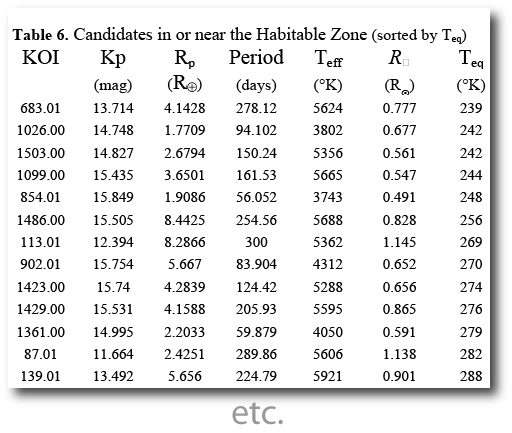
Image Source.
The Kepler Candidates were just announced! My immediate sensation at seeing a copy of the associated paper is not unlike those cheesy contests where you’re allowed 60 seconds in a grocery store to grab whatever you can grab for free.
The most remarkable and unexpected development seems to be contained in Table 6 of the paper. Here, it looks as if candidates identified during the first four months of data collection have had their confidence levels increased through the use of additional transit measurements taken after September 16th, 2009. This allows for the identification of fifty candidate planets that might be considered prospects for potential “habitability”.
I ran the fifty planets in the table through my valuation formula (see here, and here.)
The total value of the planets in Kepler paper’s Table 6 is USD 295,897.65. As with most distributions of wealth, this one is highly inequitable — the most valuable planet candidate in the newly released crop is KOI 326.01, to which the formula assigns a value of USD 223,099.93. Assuming 5g/cc density, this planet has a mass of ~0.6 Earth masses, which is actually a little on the low side as far as the valuation formula is ensured. Nevertheless, USD 223,099.93 is a huge increase in value over Gl 581c, which charts at USD 158.32.
Back in 2009, I wrote that (in my opinion) the appropriate threshold for huge media excitement is USD 1M. With the planets in Table 6 of the paper, we are starting to get very close to that.
Here are the planets in the table with a formula valuation greater than one penny:
(These numbers are associated with a little bit of uncertainty. I’m using Kepler magnitudes rather than V magnitudes, and assuming 5 gm/cc. I’m also assuming that stellar mass goes as stellar radius. Running a cross correlation with the other tables in the paper will change the values slightly, but not substantially.)




On the other hand, the study of Selsis et al. (2007) of the expected conditions in the infamous system Gliese 581 pointed out that a necessary condition for habitability is a Teq below about 270 K. Some of those candidates would need some pretty reflective atmospheres to support habitable conditions…
Pingback: Populär Astronomi - » Uppdaterat om Keplers nya planeter: Det finns massor av lovande planeter därute
In fact having taken more of a look at this, I think your valuation formula needs adjustment: it is calibrated for planets too close to the star, at least using the Kepler team assumptions for computing Teq values. Doing the calculation in terms of incident flux, 326.01 comes out at 2.88 times the Earth and too close to the star to be habitable. Doing a comparison with the habitable zone formulae in Underwood, Jones and Sleep (2003), only 1026.01, 1503.01 and 854.01 in your list of candidates come out in the most conservative habitable zone. 1361.01 and 87.01 are between the “Early Venus” and runaway greenhouse limits and the rest are too hot.
I really like this concept, and am super excited that there are already 2 candidates more valuable than Mars!
But I think your formula only works for the value to society of observing a planet (or moon) from Earth, Earth’s orbits, and it’s Lagrange points. For instance, it can be easily demonstrated that we value exploring Mars by more than $14,000. It will cost about $1.8 billion USD to launch the Mars Science Lab in November of this year. And that doesn’t include the three other missions currently operating there and the several others in development. But the difference is that those are missions to make observations THERE, either in orbit or from the surface. We probably don’t spend much at all on observing Mars from the Earth, and only take occasional shots from Hubble – because there isn’t much interesting left to learn from this distance.
So I think there would be utility in creating a second equation to calculate the value to society of traveling to a planet or moon with potential to harbor or sustain life. And distance (or delta V) from the Earth to that location would be weighed a lot more heavily in this sister equation.
Pingback: » Iti permiti sa cumperi o planeta? Afla cat costa Pamantul!
Pingback: The hottest ec. Drake’s formula after 1960! Find out how much the Earth!Cea mai tare ec. dupa formula lui Drake din 1960!!! « gabrielteodorescu
Pingback: Hitting the Exoplanet Jackpot
Pingback: LBO « molybdenum
Pingback: Calcula el precio de la Tierra « :: ZTFNews.org